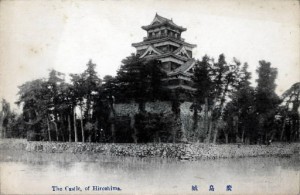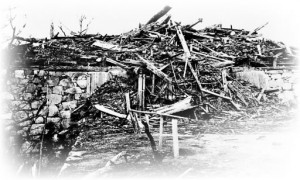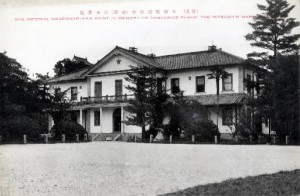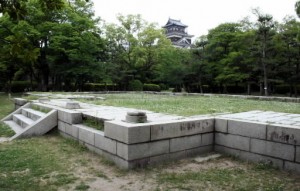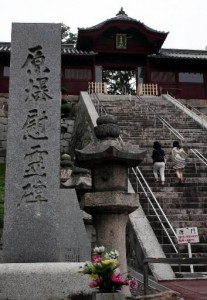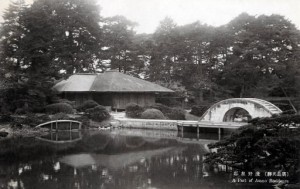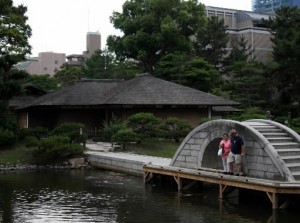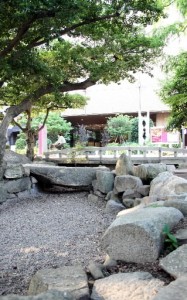Peace Seeds: Teens in Hiroshima Sow Seeds of Peace (Part 12)
Jul. 16, 2015
Part 12: Cultural assets lost in the atomic bombing
Seventy years ago, scores of people in Hiroshima were killed or injured in the atomic bombing of August 6, 1945. In addition to the lives of human beings and other living things, buildings of cultural value and historical sites were lost. These could have conveyed the activities of those who came before us.
Guidebooks and maps show buildings which carry scars from the atomic bombing. But do we pay any attention to the things that have vanished? The junior writers visited such sites and learned about cultural assets and historical places in the city affected by the atomic bombing. We were guided by Masayuki Miura, 60, a professor at the graduate school of Hiroshima University and an expert in cultural assets.
Today these buildings are in various states: some are simply remnants of stone which can barely conjure the image of their former shape; some were restored to their original condition after the war; and some were moved to another location, with parts of them left behind.
The war and the atomic bomb destroyed what our predecessors had inherited and developed. By visiting these sites, the junior writers realized the sin and folly of war.
Historical sites destroyed by war
1. Hiroshima Castle (Motomachi, Naka Ward)
Hiroshima Castle was constructed by Mori Terumoto from around 1592 to 1599, and it then watched over the city for about 350 years. The castle collapsed in the atomic bombing.
Prior to the Battle of Sekigahara in 1600, Hiroshima Castle was the second largest castle in Japan, after Osaka Castle. If the original Hiroshima Castle had remained standing, it would be the oldest one today, older than Himeji Castle in Hyogo Prefecture and Matsumoto Castle in Nagano Prefecture. Professor Miura said, “The original castle in Hiroshima would have been designated a national treasure because its main gate, covered with iron plates, had historical value, and could have been considered a World Heritage site.”
The castle was destroyed by the blast, but fire did not consume the ruins. It is said that people who lost their homes used the columns and pillars of the castle as building material for temporary shelters or made fuel from the wood. Kazuhiro Tamaki, 47, the chief curator of the castle, said, “The castle could have been restored, but people couldn’t think about restoring it in the aftermath of the atomic bombing. Because the ruins were used by survivors, it can be said that the castle saved many lives.” (Nanase Shode, 15 and Yukiho Saito, 13)
2. Remains of the Hiroshima Imperial Headquarters (Motomachi, Naka Ward)
The Imperial Headquarters was the highest-ranking authority overseeing the Japanese military in wartime. It was located in Hiroshima during the Sino-Japanese War (1894-1895) and the Emperor Meiji stayed here for over seven months. Hiroshima and Tokyo were linked by rail and the Ujina Port was completed. Soldiers and supplies were sent off to the war front from this port. A temporary chamber for the Imperial Diet was also established in Hiroshima, turning it into a “temporary capital.”
In the early years of the Meiji Period (1868-1913), the 5th Divisional Headquarters building was converted into a western-style wooden building. When the Sino-Japanese War ended, and even after the building was no longer used, it was included in the itinerary for school trips, along with Hiroshima Castle. Mr. Tamaki said, “An authentic artifact like this conveys the military history of Hiroshima.”
If the Imperial Headquarters still existed, it would conjure images of Japan’s history of war. But the building was destroyed in the atomic bombing, leaving behind only the foundation stones. But the fact that the Imperial Headquarters was once located here, and was the base of operations for the Sino-Japanese War, remains unchanged. (Shino Taniguchi, 16 and Nanase Shode, 15)
3. Hiroshima Toshogu Shrine (Futaba-no-sato, Higashi Ward)
Hiroshima Toshogu Shrine was built to enshrine the soul of Tokugawa Ieyasu by Asano Mitsuakira, a feudal lord of Hiroshima, in 1648. Each building was embellished with elaborate carvings and colorful ornaments. The main shrine with its cypress bark roof, central gate, and front shrine were incinerated by the thermal rays of the atomic bomb. The Chinese-style gate and transept escaped the flames, but the force of the blast sent them tilting to one side. They were torn down and rebuilt, the work completed in 2012.
Until the atomic bombing, the main buildings had lingered since the time they were constructed. Hiroshima Toshogu Shrine was an exceptional case among the Toshogu shrines of Japan because it was completed with a full arrangement of buildings.
In the aftermath of the atomic bombing, some tents were set up under the shrine gate and the shrine served as a temporary aid station. Noriaki Kubota, 82, the head priest of the shrine, said, “It is regrettable that some buildings burned down, but many people lost their lives in the atomic bombing so I should be content that only some parts of the temple survived.” (Shino Taniguchi, 16)
4. Seifukan in Shukkeien Garden (Kaminobori-cho, Naka Ward)
Shukkeien Garden was established for the Asano Family, who were feudal lords of Hiroshima, in the early Edo Period (1603-1867). Seifukan, designed as a tea ceremony house, stood in the center of the garden. It is believed to have been built in the 1780s, and mainly used to entertain guests by serving tea. Seifukan had a shingled roof and thin posts, which made the framework look elegant and delicate. The building did not appear strong, but it was carefully preserved for over 150 years.
But in the atomic bombing, the garden was annihilated and Seifukan burned to the ground. In 1964, it was rebuilt, despite the lack of adequate materials. If the original building still stood from the Edo Period, it could convey the architectural technology of that time more precisely than any other structure. (Nako Yoshimoto, 16)
5. Kokutaiji Temple (Komachi and Nakamachi, Naka Ward)
Kokutaiji Temple, symbolizing the castle town of Hiroshima, was on spacious grounds. But the temple, including the main building and the graves of the Asano Family, feudal lords of Hiroshima, were incinerated in the atomic bombing. In 1978, the temple moved to Nishi Ward. Other buildings, including a hotel, were built on the site where the temple once stood. Atago Pond, which was part of the temple grounds, remains at that location today and reminds us of that former time. Eimyo Noma, 64, now the head priest of the temple, said, “There should not be war. People must not kill others. War destroys culture, too. Do not forget that it’s thanks to many things we are able to live our lives.” (Tokitsuna Kawagishi, 14)
The rest of the story
Today’s Seifukan in Shukkeien Garden looks like the one in an old picture postcard. But an experienced gardener told us, “I think people had to rely on their imagination for the details when they were rebuilding it.” The original structure suddenly vanished in the bombing and the details of its construction weren’t clearly known, which became a source of misfortune in handing down the culture it represented. This is a crime of the war and the atomic bombing. (Nako Yoshimoto)
Hiroshima Toshogu Shrine will hold an annual festival to mark the 400th anniversary of Tokugawa Ieyasu’s death, and a portable shrine procession will be held. The portable shrine miraculously survived even after the atomic bombing. The procession, in conjunction with an imperial memorial ceremony held every 50 years, has taken place since 1815. I sense the importance of this tradition and I think that war must not break the links of history. (Shino Taniguchi)
War brings grief to human beings and destroys the culture they have developed over time. Mr. Noma, the head priest of Kokutaiji Temple, said, “We must not hurt other people.” To me, an atomic bomb and the act of bullying, though the scale is different, are the same in the sense that they both inflict suffering on people’s bodies or hearts. (Tokitsuna Kawagishi)
The atomic bombing deprived people of many things which convey the history of Hiroshima. But the historical fact that these buildings once existed doesn’t disappear even though they had to be rebuilt or the land where they once stood is now vacant. I think some things are still meaningful even though they’re invisible to the eye, and there may be other invisible A-bombed things that we overlook. I want to turn my attention to those things. (Nanase Shode)
-------------------------------------
Miku Yamashita, a second-year high school student; Ariel Du Temple, a second-year high school student; Nako Yoshimoto, a first-year high school student; and Tokitsuna Kawagishi, a second-year junior high school student, created the map and took current photos.
Impressions of the junior writers
Mr. Tamaki, the chief curator of Hiroshima Castle, told us the interesting story behind the castle. It was the first time I had heard that Hiroshima Castle was blown down by the blast of the atomic bomb, that it hadn’t been destroyed by fire. He said that the castle could have been rebuilt with the wood from the wreckage, and I wondered why people didn’t do this. But he explained that the survivors used the wood to help them through the difficult period that followed the end of the war, which is understandable. (Yukiho Saito)
Kokutaiji Temple reminds me of a junior high school or high school, and I didn’t know much about the temple itself. At the site where the temple once stood, about 500 meters from the hypocenter, is Atago Pond and some other buildings. The atomic bomb instantly obliterated the Kokutaiji buildings and the traditions people had preserved for many years. I won’t forget that the atomic bomb took away not only the lives of many human beings but also the buildings loved by the local people. (Tokitsuna Kawagishi)
Because of the atomic bombing, we can no longer see what prewar Hiroshima was like. At first, I gathered information because I wished I could see the original castle from the time of the Mori clan, but now I realize that it’s not only the things that are still visible that can provide evidence of history. Invisible things can tell us a lot about the past. (Nanase Shode)
After I gathered information about Hiroshima Castle and Shukkeien Garden, I found that there are many things I don’t know, though I thought I did. If the original Hiroshima Castle was still standing, it would have been designated a national treasure, and some parts of Seifukan in Shukkeien Garden had to be imagined so the structure could be rebuilt. The war and the atomic bombing must not be repeated because they destroy not only people’s lives but also the culture and buildings that people have carefully preserved. (Nako Yoshimoto)
As an exchange student, the activities of a junior writer provide a good opportunity to learn about the culture of Hiroshima. This time, my job was to take photos. Seifukan in Shukkeien Garden was rebuilt after it burned down in the atomic bombing. It’s a shame that we can’t see the original building. But from its current version, we can think about the history of prewar Hiroshima. I think this is very important. (Ariel Du Temple)
I visited Hiroshima Castle two times. The first visit wasn’t connected to being a junior writer, but I learned how the Imperial Headquarters was established in Hiroshima. A few days later, I visited the castle again to conduct the Peace Seeds interview, and I felt the history of the war sharply as I stood at the remains of the Imperial Headquarters, which was a base of operations for the war effort. In those days, people weren’t allowed to enter the area. I was overwhelmed as I thought of that time and the importance of history. (Shino Taniguchi)
I was involved in making a map of the positions of the buildings we visited. I hadn’t learned about these buildings in my peace studies at school, and I didn’t associate them with the atomic bombing. Before, when I showed an exchange student around Hiroshima Castle, I didn’t explain about the bombing. But now that I think about it, these buildings are about two kilometers from the hypocenter and I imagine they were heavily damaged. I think it’s important to imagine what they looked like 70 years ago, though we can’t see them now. (Miku Yamasita)
What is Peace Seeds?
Peace Seeds are the seeds of smiles which can be spread around the world by thinking about peace and the preciousness of life from various viewpoints. To fill this world with flowering smiles, 49 junior writers, from the sixth grade of elementary school to the last year of high school, choose themes, gather information, and write articles.
(Originally published on June 25, 2015)

